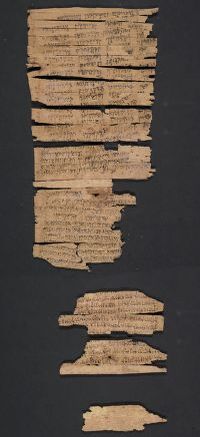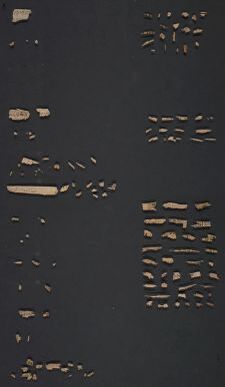
 This Gandhara Buddhist Text contains information on the parallel lives of fifteen buddhas: Dīpaṅkara, Sarvābhibhū, Padmottara, Atyuccagāmin, Yaśottara, Śākyamuni [I], Tiṣya, Vipaśyin, Śikhin, Viśvabhū, Krakucchanda, Konākamuni, Kāśyapa, Śākyamuni [II] (also known as Siddhartha Gautama), and Maitreya.
This Gandhara Buddhist Text contains information on the parallel lives of fifteen buddhas: Dīpaṅkara, Sarvābhibhū, Padmottara, Atyuccagāmin, Yaśottara, Śākyamuni [I], Tiṣya, Vipaśyin, Śikhin, Viśvabhū, Krakucchanda, Konākamuni, Kāśyapa, Śākyamuni [II] (also known as Siddhartha Gautama), and Maitreya.
The scroll gives the buddhas’ predictions of Śākyamuni’s future coming as the Buddha; his four courses of training under the other buddhas; their lifespans; eons in which they lived; social class into which they were born; their assemblies of disciples; and duration of their teachings.
“The ancient kingdom of Gandhara (today’s Afghanistan and Pakistan) is the source of the oldest Buddhist manuscripts in the world, as well as the oldest manuscripts from South Asia in existence. Acquired in 2003, the Library’s Gandhara scroll roughly dates between the first century BCE and first century CE. Its language is Gandhari, a derivative of Sanskrit, and the script is called Kharoshthi. Scholars have informally called this scroll the Bahubuddha Sutra, or ‘The Many Buddhas Sutra,’ because it resembles a text with a similar name in Sanskrit. The scroll discusses the lives of fifteen buddhas.
The text is narrated by Shakyamuni Buddha who gives very short biographies of thirteen buddhas who came before him, followed by his birth and emergence as Shakyamuni Buddha, and ending with the prediction of the future buddha, Maitreya.
Provided by Library of Congress Asian Division staff.
The talk starts around 7 minutes.
This Buddhist scroll on birch bark originates from the ancient Buddhist region of Gandhara (Pakistan and Afghanistan today) and is one of the oldest known Buddhist manuscripts. It is written in the Gandhari Prakrit language in Kharoshthi script, which is read from top to bottom and right to left. Because the scroll contains writing on both sides, the scribe would have flipped the scroll vertically to continue writing on the verso.
The manuscript is in six large fragments and approximately 130 smaller fragments; mostly complete with the very beginning and end missing. Fragments are stored flat in two custom clamshell boxes measuring 73.5 x 45 x 7.8 cm. One box contains the six large fragments and the other box contains the smaller fragments.
Digitised images of this manuscript reflect the number, orientation, and order of fragments upon its unrolling and preservation in glass casing. In the image of the recto of the six large fragments, the three smallest fragments should be rotated 180 degrees to read the scroll.
 According to Richard Salomon, director of the British Library-University of Washington Early Buddhist Manuscripts Project, it is significant that the Library’s scroll is about 80 percent complete and only missing the very beginning and end.
According to Richard Salomon, director of the British Library-University of Washington Early Buddhist Manuscripts Project, it is significant that the Library’s scroll is about 80 percent complete and only missing the very beginning and end.
Many of the other Gandharan manuscripts known to scholars are more fragmentary.
Images: 2,000-Year-Old Buddhist Text of Early Buddhism Now Online at US Library of Congress.
Categories: Buddhism, Encyclopedia, History, Mahayana, Texts, Video

Are the Ghandara manuscripts the same as the introductory volume to the Jataka Tales?
If not, are there translations available?
Thanks
I don’t think so Jikusan,
As a commentator says, ‘Scholars have informally called this scroll the Bahubuddha Sutra, or ‘The Many Buddhas Sutra,’ because it resembles a text with a similar name in Sanskrit [Try this link]. The scroll discusses the lives of fifteen buddhas. While the Jatakas talk of the Buddha’s previous lives.
The Text remains are very fragmented, any translation would be ragged at best.
However, marvellous discovery all the same.
Cheers,
R